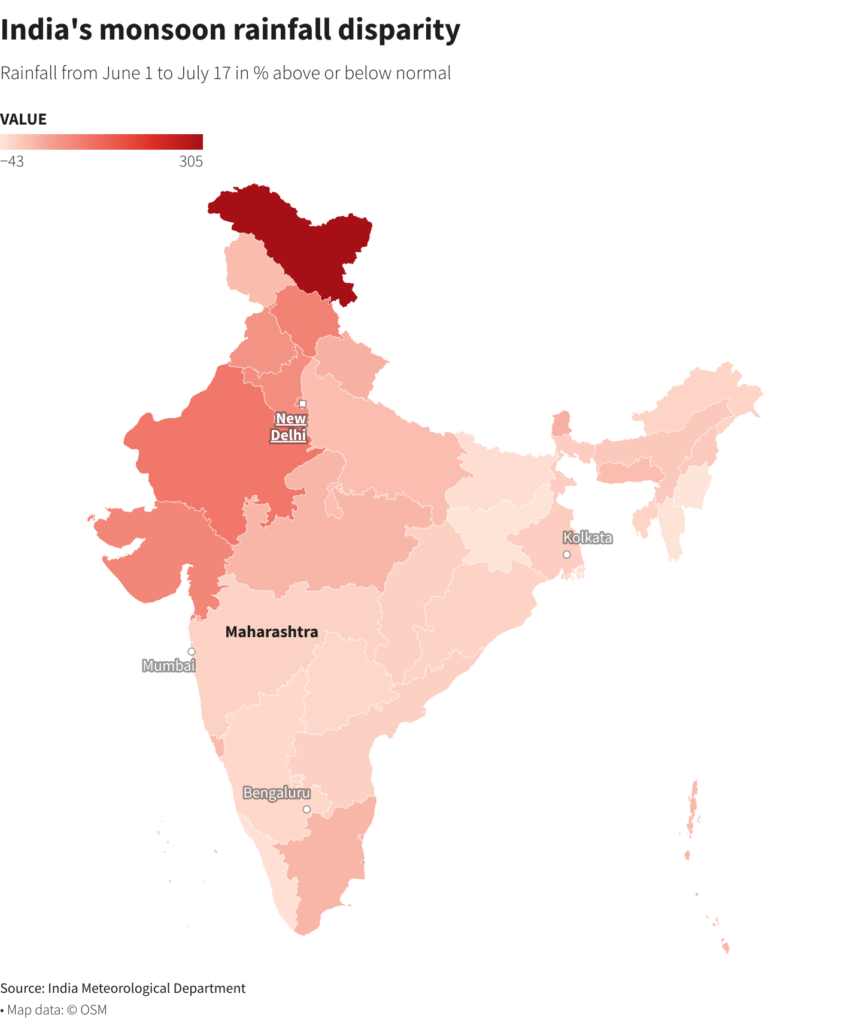Tags
Why Indian farmers worry despite ‘average’ monsoon rains

A farmer carries rice saplings in her field on the outskirts of the western Indian city of Ahmedabad, India, February 1, 2023. REUTERS/Amit Dave
MUMBAI, July 18 (Reuters) – India has received average monsoon rains since the start of the season on June 1, despite concerns that an El Nino weather pattern could lead to lower rainfall this year.
Delay in the arrival of the monsoon led to a large rain deficit up to mid-June, but heavy rains since the last week of June erased the shortfall.
While average monsoon rains are ordinarily good for Indian farmers, uneven distribution this year has created new worries.
ERRATIC DISTRIBUTION
Some northern and north-western states have received excessive rains, while southern and eastern regions have been unusually dry.
Only a third of the country has received average rainfall so far this season, according to India Meteorological Department (IMD) data. Meanwhile, about 34% of India has received deficient rains and 32% excessive rainfall, the data shows.
States such as Haryana, Punjab, Gujarat, Himachal Pradesh, and Rajasthan received nearly double their normal rainfall so far this season. Jharkhand, Bihar, Telangana, Chhattisgarh and Kerala have received up to 41% less rainfall than normal.

WHAT IS THE IMPACT ON SUMMER-SOWN CROPS?
The sowing of rice, cotton, oilseeds and pulses has gained momentum in the past fortnight after a slow start but plantings still lag last year’s progress.
Heavy rainfall has damaged newly planted rice crops in northern states such as Punjab, Haryana, Himachal Pradesh and Uttar Pradesh, and many farmers may have to replant.
On the other hand, scant rainfall has delayed the planting of rice, corn, cotton, soybeans, groundnuts and pulses in states including Maharashtra, Telangana, Andhra Pradesh, Chhattisgarh, Bihar and West Bengal.
Sugarcane growers in top producing Maharashtra and Karnataka states are also worried that scant rainfall during the crop’s crucial growth period could trim yields and reduce sugar output.
WHICH CROPS ARE MOST AFFECTED?
Rice, vegetables and pulses are significantly affected by the uneven rainfall distribution.
Paddy fields in northern states have been submerged for over a week, destroying newly planted seedlings, and forcing farmers to wait for waters to recede so they can replant.
In other major rice-growing states, including West Bengal, Bihar, Chhattisgarh, Andhra Pradesh and Telangana, farmers have prepared paddy nurseries but have been unable to transplant the seedlings due to inadequate rainfall.
The area under rice cultivation had been expected to increase after New Delhi raised the rice purchase price, but industry officials now estimate a marginal decrease. Farmers so far have planted paddy rice on an area 6% smaller than in 2022.
Vegetables such as tomatoes, eggplant, capsicum and spinach are also affected by erratic rainfall distribution. Standing crops in northern India have been damaged by floods, while southern planting has been delayed. As a result, prices of certain vegetables including tomatoes have hit record highs.
The planting of pulses, a crucial protein source for India’s large vegetarian population, has also been delayed.
Pulses are predominantly rain-fed crops, and delay will likely lead to lower-than-normal yields.
So far, pulses have been planted on an area 13% smaller than last year, according to data compiled by the farm ministry. Soybean and cotton planting areas are down by 2% and 12%, respectively.
WHAT DOES DELAYED PLANTING MEAN FOR YIELDS?
Delays in planting after mid-July typically result in lower yields in much of India. As mid-September approaches, temperatures begin to rise in many regions, which can hurt pod formation and pod filling in crops that were planted late.
Weather agencies have forecast that El Nino could curtail rainfall in August and September – when crops reach the maturity phase and need sufficient moisture. Lower rainfall during this period could also lead to reduced production.
WHAT’S THE IMPACT ON WINTER-SOWN CROPS?
Delays in planting summer crops lead to delays in harvesting, ultimately resulting in the late sowing of winter crops such as wheat, rapeseed and chickpeas.
Cold weather is crucial for winter crops, but higher temperatures in recent years during the maturity phase has resulted in yield losses.
Weather agencies have predicted a strong El Nino during the Indian winter months, and that could mean higher-than-normal temperatures and reduced yields of wheat and rapeseed.
India has struggled to control wheat prices for over a year, and lower output in the upcoming season could complicate those efforts. Lower rapeseed output may necessitate an increase in vegetable oil imports.
Reporting by Rajendra Jadhav; Editing by Tony Munroe and Tom Hogue
https://www.reuters.com/world/india/why-indian-farmers-worry-despite-average-monsoon-rains-2023-07-18/Published Date: July 18, 2023





